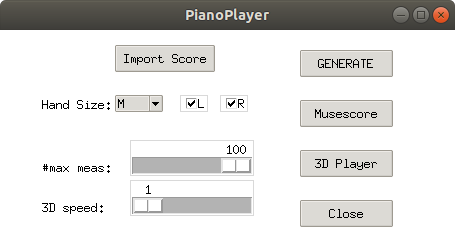Automatic piano fingering generator.
Find and animate the optimal fingering combination to play a score
and visualize it in 3D with vtkplotter
and music21.
(sudo) pip install --upgrade pianoplayerTo visualize the annotated score install for free musescore:
sudo apt install musescoreTo open a 3D visualization, install VTK with one of these command lines:
sudo apt install vtk7
# or
conda install -c conda-forge vtk
# or
(sudo) pip install vtk
#
# for sound:
sudo apt install libasound2-dev
(sudo) pip install simpleaudioExample command line:
pianoplayer scores/bach_invention4.xml --debug -n10 -r -v -mb
will find the right hand fingering for the first 10 measures,
pop up a 3D rendering window and invoke musescore,
a MusicXML
file output.xml will be saved.
pianoplayer # if no argument is given a GUI will pop up (on windows try `python pianoplayer.py`)
# Or
pianoplayer [-h] [-o] [-n] [-s] [-d] [-k] [-rbeam] [-lbeam] [-q] [-m] [-v] [--vtk-speed]
[-z] [-l] [-r] [-XXS] [-XS] [-S] [-M] [-L] [-XL] [-XXL]
filename
# Valid file formats: MusicXML, musescore, midi (.xml, .mscz, .mscx, .mid)
#
# Optional arguments:
# -h, --help show this help message and exit
# -o , --outputfile Annotated output xml file name
# -n , --n-measures [100] Number of score measures to scan
# -s , --start-measure Start from measure number [1]
# -d , --depth [auto] Depth of combinatorial search, [2-9]
# -rbeam [0] Specify Right Hand beam number
# -lbeam [1] Specify Left Hand beam number
# --debug Switch on verbosity
# -m, --musescore Open output in musescore after processing
# -b, --below-beam Show fingering numbers below beam line
# -v, --with-vtk Play 3D scene after processing
# --vtk-speed [1] Speed factor of 3D rendering
# -z, --sound-off Disable sound
# -l, --left-only Fingering for left hand only
# -r, --right-only Fingering for right hand only
# -x, --hand-stretch Enable hand stretching
# -XXS, --hand-size-XXS Set hand size to XXS
# -XS, --hand-size-XS Set hand size to XS
# -S, --hand-size-S Set hand size to S
# -M, --hand-size-M Set hand size to M
# -L, --hand-size-L Set hand size to L
# -XL, --hand-size-XL Set hand size to XL
# -XXL, --hand-size-XXL Set hand size to XXLIf using the GUI:
- press Import Score
- press GENERATE (
output.xmlis written) - press Musescore to visualize the annotated score
- press 3D Player to show the animation (closing it with
Escwill quit the application)
Example output displayed in musescore:

If VTK is installed click on 3D Player for a visualization (in interactive mode, drag mouse
to move the scene, right-click drag to zoom). You will see the both hands playing but hear the right hand notes only.
Chords are rendered as a rapid sequence of notes.
The algorithm minimizes the fingers speed needed to play a sequence of notes or chords by searching through feasible combinations of fingerings.
- Your hand size (from 'XXS' to 'XXL') which sets the relaxed distance between thumb and pinkie (e.g. 'M' = 17 cm)
- The beam number associated to the right hand is by default nr.0 (nr.1 for left hand).
You can change it with
-rbeamand-lbeamcommand line options. - Depth of combinatorial search, from 2 up to 9 notes ahead of the currently playing note. By default the algorithm selects this number automatically based on the duration of the notes to be played.
One possible advantage of this algorithm over similar ones is that it is completely dynamic, which means that it takes into account the physical position and speed of fingers while moving on the keyboard and the duration of each played note. It is not based on a static look-up table of likely or unlikely combinations of fingerings.
- Some specific fingering combinations, considered unlikely in the first place, are excluded from the search (e.g. the 3rd finger crossing the 4th).
- Hands are always assumed independent from each other.
- Repeated notes for which pianists often alternate fingers will be assigned to the same finger.
- In the 3D representation with sounds enabled, notes are played one after the other (no chords), so the tempo within the measure is not always respected.
Fingering a piano score can vary a lot from indivual to individual, therefore there is not such a thing as a "best" choiche for fingering. This algorithm is meant to suggest a fingering combination which is "optimal" in the sense that it minimizes the effort of the hand avoiding unnecessary movements.
- Improved fingering prediction by allowing some degree of hand stretching (stil experimental, use
-xoption). - Patch in music21 for fingering positions as shown in musescore.
If fingering numbers are still not clearly visible use
-boption. - Small notes/ornaments are ignored.
- Some odd fingering in left hand of scores/mozart_fantasia.xml needs to be fixed.

